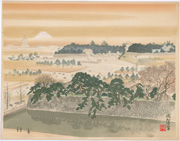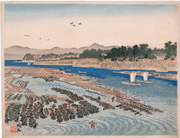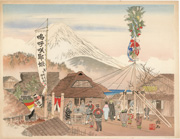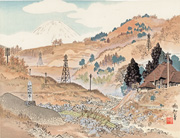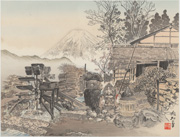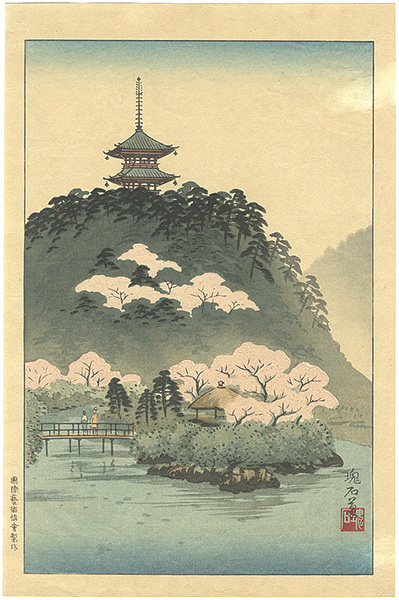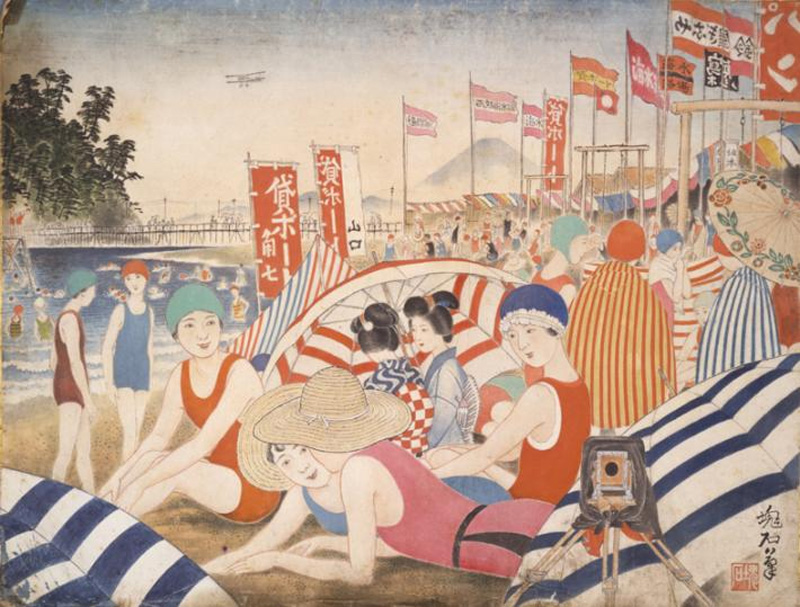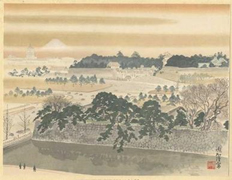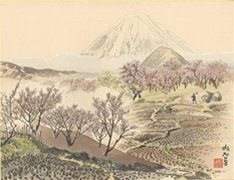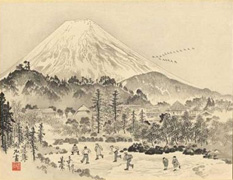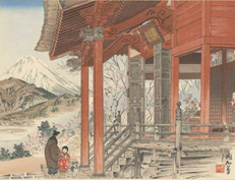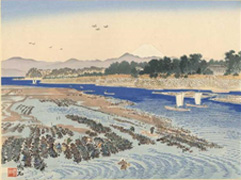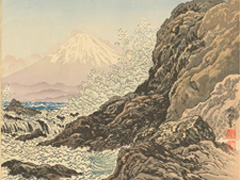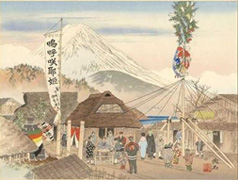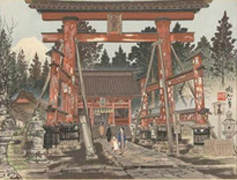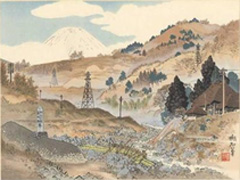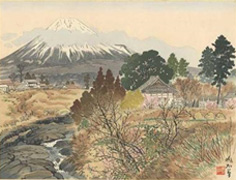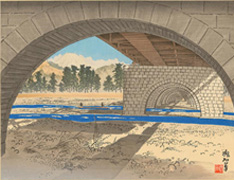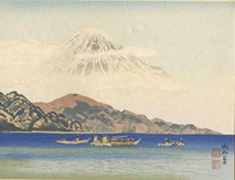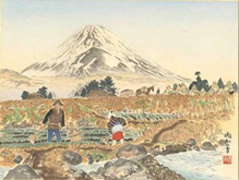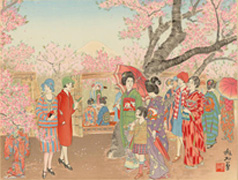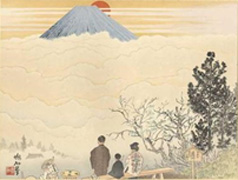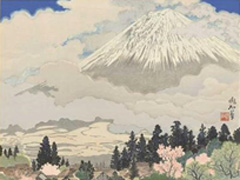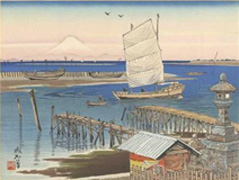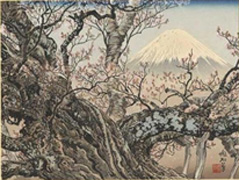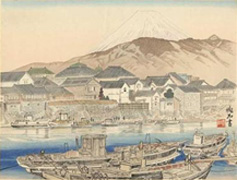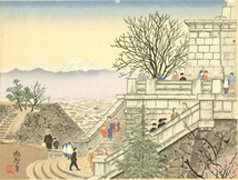Prints in the Collection
Biographical Data
Biography
Sources: Guide to Modern Japanese Woodblock Prints: 1900-1975, Merritt, Helen and Nanako Yamada, University of Hawaii Press: Honolulu, 1992 p. 50; Ohmi Gallery website 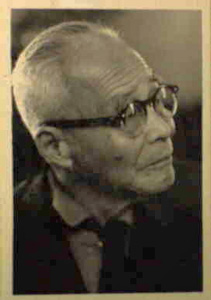 | Nothing is known of this artist’s personal life other than he was born in Okayama and lived in Osaka. The work for which Jōkata is unquestionably best known is his series of prints depicting Mount Fuji. While nothing seems to be known of the artist's life, when his series of prints titled Twenty-Five Views of Mount Fuji was published in 1931, it was accompanied by essays praising his work from three well-known artists of the time, two of whom were members of the Imperial Art Academy, suggesting Jōkata was fairly prominent at the time. In addition to his prints depicting Mount Fuji, one other woodblock print, shown below, is extant along with one painting on silk, also shown below. A fuller discussion of Jōkata's Mount Fuji prints follows. Note: The photo of the artist on the left may have originated with the artist's grandson. It appears on the website http://www.fjsan.net/fj0412kaiseki.htm |
The Kaiseki Mount Fuji Prints
Jōkata self-published (under the name Kaiseki Print Publication Society 塊石版画刊行会) the series Twenty-Five Views of Mt.Fuji1 in 1931, which was carved by Kawatsura Yoshio (1880-1963), who was also a print maker. The prints present traditional views of sacred Mount Fuji, often accompanied by modern elements, such as airplanes and transmission towers.
Merritt and others2 report that Jōkata created a series of twelve landscapes of Mount Fuji "ca. 1929", also carved by Kawatsura, but this cannot be verified. It seems most likely that she had incomplete information and made her deduction about the number of prints and their date looking at a partial set of prints from the 1931 series. Outside of the twenty-five prints depicting Mount Fuji belonging to the 1931 series, thumbnails of which are provided in the table below, I have come across only one additional print by Jōkata depicting Fuji. Unfortunately, this print (see below) depicting Mount Fuji as seen from the Shōnan Coast, crowded with groups of women in modern bathing suits and traditional dress, is not dated.
定方塊石「題名不詳(湘南海岸からの富士)
Jōkata Kaiseki [title unknown (Mount Fuji from the Shōnan Coast)]
The table of contents for the 1931 series, shown towards the bottom of this page, contains three laudatory commentaries by well-known artists of the time - Kurushima Takehiko (1874-1950), one of the best-known authors of children's literature of the period, Yūki Somei (1875-1957), a Japanese-style and Western-style painter (who also designed prints) and a member of the Imperial Art Academy and Kanokogi Taskeshirō (1874-1941), a Western-style painter and print artist, also a member of the Imperial Art Academy. Titles for the commentaries can be loosely translated as "On the Occasion of a Close Friend's Outstanding Achievement", "A Marvelous Work that Opened up the Frontier's Unexplored Boundary" and "Exquisite and Excellent Work for Future Generations."
While the table of contents tells us that the complete twenty-five print series 富士二十五景 (Twenty-Five Views of Mount Fuji) was limited to an edition of one hundred prints, I believe the prints were also issued separately in unknown numbers. Other information in the table of contents sheet tells us that the cost for the entire set was 250 yen 貳百五十圓3; that the paper used for the prints was a special paper made in the famous paper-making town of Echizen and that the prints were hand-carved and hand-colored woodblock prints 手摺手彩色木版畫. As shown in the below table, the table of contents indicates that the prints making up the series were divided into twelve folders or envelopes, the first eleven containing two prints each and the twelfth containing three prints.
The prints in the series were issued both without margins and also with small margins. I believe that all the prints issued as part of the limited edition 1931 series are without margins, such as IHL Cat. #1194, and that prints with margins, such as IHL Cat. #1669, may have been issued individually at a later date.
The below table provides thumbnails of each print along with my English translation of the Japanese title as given in the table of contents; a transcription of the Japanese title appearing in the table of contents; and an "alternate title" sometimes used by other sources which may have been present on some of the presentation folders accompanying individual prints. Note there are no titles on any of the prints themselves.
Twenty-Five Views of Fuji 富士二十五景
published by Kaiseki Print Publication Society 塊石版画刊行会 in Shōwa 6 (1931)
Thumbnail Titles: English Translation
As transcribed from Table of Contents
Alternate title, as it appears on the print's folderFolder Number
as shown
in ToC
The Imperial Palace and Mount Fuji
Table of Contents: 宮城と富士
Alternate Title: 皇居からの富士
A Shimosoga Plum Orchard and Mount Fuji
Table of Contents: 下曾我の梅林と富士
Alternate Title: 小田原梅園からの富士
Note: Shimosoga 下曾我 is located in
Odawara 小田原.第一輯
Mount Fuji from the South
Table of Contents: 南から見た富士
Alternate Title:
Note: English title is sometimes given as "Southern View of Fuji in Early Spring"
Lake Araya and Mount Fuji
Table of Contents: 新屋の大池と富士
Alternate Title:
第二輯
Kannon Temple at Matsuda and Mount Fuji
Table of Contents: 松田の觀音堂と富士
Alternate Title: 初春- 松田からの富士
Note: Alternate Title translates as "Early Spring, Mount Fuji from Matsuda."
Benten Island, Lake Hamana and Mount Fuji
Table of Contents: 濱名湖辨天嶋と富士
Alternate Title:
Note: Bentenjima is a small island located in the south part of Lake Hamana.第三輯
Enoshima and Mount Fuji
Table of Contents: 江ノ島皃淵と富士
Alternate Title: 三津海岸からの富士
New Year at the Lakshore and Mount Fuji
Table of Contents: 湖畔の正月と富士
Alternate Title: 河口村の富士
Note: Alternate Title translates as "Mount Fuji from Kawaguchi Village"第四輯
Fujiyoshida [Sengen] Shrine and Mount Fuji
Table of Contents: 吉田神社と富士
Alternate Title: 北口本宮富士浅間神社
Note: Fujiyoshida Sengen Shrine, formally known as Kitaguchi Hongū Fuji Sengen Jinja (北口本宮冨士 浅間神社, "North Entrance Fuji Sengen Shrine"), is the main Sengen Shrine on the north side of the mountain.
The Sakawa River and Mount Fuji
Table pf Contents: 洒匂川と富士
Alternate Title: 酒匂川の富士第五輯
Fukusenji and Mount Fuji
Table of Contents: 福泉寺と富士
Alternate Title:
Lake Kawaguchi and Mount Fuji
Table of Contents: 河口湖と富士
Alternate Title:第六輯
Ooigawa and Mount Fuji
Table of Contents: 大井川と富士
Alternate Title:
Note: English title sometimes seen as "Mount Fuji from the Oigawa Bridge"
The Rural Cottages in Onuma and Mount Fuji
Table of Contents: 小沼の田家と富士
Alternate Title:第七輯
The Port of Shimizu and Mount Fuji
Table of Contents: 清水港と富士
Alternate Title:
Sanomura and Mount Fuji
Table of Contents: 佐野村と富士
Alternate Title: 佐野の富士第八輯
The Peach Orchards of Hara and Mount Fuji
Table of Contents: 原の桃と富士
Alternate Title:
Asukayama and Mount Fuji
Table of Contents: 飛鳥山と富士
Alternate Title: 飛鳥山の桜と富士
Note: Alternate Title references the "cherry blossoms" of "Asukayama".
第九輯
Otodomenotaki and Mount Fuji
Table of Contents: 音止の瀧と富士
Alternate Title:
Mount Shichimen and Mount Fuji
Table of Contents: 七面山と富士
Alternate Title:第十輯
Kamiide and Mount Fuji
Table of Contents: 上井出と富士
Alternate Title:
Kisarazu and Mount Fuji
Table of Contents: 木更津と富士
Alternate Title: 木更津海岸と富士第十一輯
The Komadome Cherry Tree and Mount Fuji
Table of Contents: 駒止の櫻と富士
Alternate Title:
The Kano River and Mount Fuji
Table of Contents: 狩野川と富士
Alternate Title:
Kōfu Park and Mount Fuji
Table of Contents: 甲府公園と富士
Alternate Title: 舞鶴城からの富士
Note: Alternate Title reads "Mount Fuji from Maizuru Castle" which is located in Kōfu Park which is also called Maizuru Castle Park.第十二輯
1 Title of this series is often seen as Twenty-Five Views of Mt.Fuji in the Four Seasons, but I have not seen this title on any of the documentation issued with the prints. The series is referred to as 塊石版畫富士 and 富士二十五景 in the table of contents for the 1931 series and as 士版薗傑作選 on the folders or labels for some of the prints.
2 All other sources seem to rely upon the Merritt "ca. 1929" date in Guide to Modern Japanese Woodblock Prints: 1900-1975, Helen Merritt, University of Hawaii Press, 1992, p. 50.
3 If I am reading the price correctly, 250 yen in 1931 converted to about 122 dollars U.S. which is nearly 2,000 in 2017 dollars.
